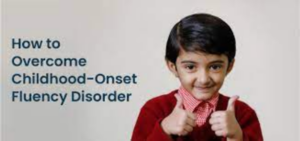NRNP 6665 WEEK 8 Study Guide: Child-Onset Fluency Disorder (Stuttering)
What is Child-Onset Fluency Disorder (Stuttering)?
 Child-Onset Fluency Disorder, also known as Stuttering Disorder, is a communication disorder characterized by disruptions in the normal flow and timing of speech.
Child-Onset Fluency Disorder, also known as Stuttering Disorder, is a communication disorder characterized by disruptions in the normal flow and timing of speech.
These disruptions are typically inappropriate for an individual’s age and expected language skills and tend to persist over time.
The disorder, which primarily affects stuttering in children, often begins between the ages of 2-6 years.
This condition may result in difficulties with producing speech smoothly, leading to feelings of frustration, embarrassment, or anxiety.
Signs and Symptoms of Stuttering Disorder in Children
The signs and symptoms of Childhood stuttering according to the DSM-5 diagnostic criteria include:

Struggling to meet your deadline?
Get your assignment on NRNP 6665 WEEK 8 Study Guide: Child-Onset Fluency Disorder (Stuttering) done by certified MDs and PhDs in the USA. ORDER NOW!
- Repetition of syllables, sounds, or monosyllabic words.
- Broken words with pauses within a word.
- Prolonging the vocalization of consonants and vowels.
- Filled or unfilled pauses in speech.
- Substituting words to avoid difficult ones.
- Producing words with excessive physical tension, such as jerking the head or fist clenching.
- Exhibiting frustration or embarrassment when speaking.
- The symptoms may also include motor movements, such as eye blinks, tics, and facial shaking.
Diagnosis of Stuttering Disorder: DSM-5 Criteria and Clinical Evaluation
To diagnose Stuttering Disorder, clinicians typically rely on the DSM-5 diagnostic criteria, which focus on a disturbance in normal fluency. There are no diagnostic tests specifically for Stuttering; instead, the diagnosis is made based on the child’s speech profile and symptoms. Stuttering diagnosis involves assessing the severity, duration, and impact on the child’s life. If the symptoms match the DSM-5 criteria, and the disruptions persist over time, a diagnosis of Child-Onset Fluency Disorder (Stuttering) is made.
Differential Diagnoses
When diagnosing Stuttering, it is important to differentiate this condition from other disorders such as sensory deficits (e.g., hearing impairment), normal speech dysfluencies, Tourette’s disorder, and side effects of medications.
Risk Factors for Stuttering
There are several Stuttering risk factors that can increase the likelihood of a child developing Child-Onset Fluency Disorder (Stuttering). These include male sex, a family history of stuttering, the onset of stuttering past the age of 3-4, and the persistence of stuttering severity beyond 7-12 months. Genetic and environmental factors in stuttering also play a role in the disorder’s development.
Prognosis of Stuttering Disorder
The prognosis for stuttering in children is generally positive. About 70-80% of children with Child-Onset Fluency Disorder recover spontaneously. However, in about 1% of children, the condition persists into adulthood, leading to stuttering in adults. Early identification and intervention, such as speech therapy for stuttering, can improve outcomes.
Treatment Options for Stuttering: Speech Therapy and Support
Treatment for Stuttering typically involves speech therapy for children by a speech pathologist. Speech therapy techniques for stuttering may include fluency shaping, where children are taught to speak slowly and clearly, and stuttering modification techniques, which focus on reducing the tension and anxiety associated with stuttering. Speech-language therapy for stuttering is the most common non-pharmacological treatment, helping children build confidence and improve their communication skills.
Parental involvement is also crucial in stuttering treatment. Parental support for stuttering can include learning to create a relaxed, non-pressuring environment, which may help reduce the severity of the condition. Speech pathologist treatment for stuttering can also be supplemented with education on how parents can support their child’s speech development.
The Role of Speech Pathologists in Treating Stuttering
Speech pathologists are trained professionals who provide speech therapy for stuttering. They evaluate the child’s speech patterns and help develop personalized treatment plans. Techniques like fluency shaping and stuttering modification are commonly used to help the child speak more fluently and with less anxiety. 
Stuttering and Its Comorbidities: ADHD, Autism, and More
Comorbidities of stuttering often include conditions such as ADHD and stuttering, autism spectrum disorder and stuttering, learning disabilities and stuttering, and anxiety disorders and stuttering. Children with comorbidities of stuttering may face additional challenges that require a more integrated approach to treatment. A comprehensive treatment plan that addresses both the stuttering and any co-occurring disorders, like phonological disorders and stuttering, is essential for better outcomes.
Cultural and Gender Considerations in Stuttering Treatment
It is important to consider cultural and gender factors when diagnosing and treating stuttering in children. Cultural considerations in stuttering treatment involve understanding how cultural norms may affect communication styles and how speech disorders are perceived. Gender differences can also influence the prevalence and progression of Child-Onset Fluency Disorder, with males being more likely to experience persistent stuttering.
Parent Education and Support for Children with Stuttering
An important aspect of stuttering support involves educating and empowering parents to help their children. Parental support for stuttering includes creating a calm, non-judgmental environment at home and encouraging the child to communicate without fear of criticism. Parents can also benefit from learning specific techniques to assist with speech therapy for children at home, which can reinforce the lessons taught during professional therapy sessions.
Non-Pharmacological Treatments for Stuttering Disorder
Currently, there are no FDA-approved pharmacological treatments for stuttering disorder. The most effective treatment remains speech therapy for stuttering, which includes fluency shaping and stuttering modification techniques. These therapies focus on improving fluency and helping children manage the stress or anxiety associated with speaking.
The Future of Stuttering Treatment: Emerging Therapies and Approaches
Research into the future of stuttering treatment continues to evolve, with emerging therapies focused on both behavioral and technological interventions. New approaches may offer more individualized treatments, including virtual therapy sessions, mobile apps, and other digital tools aimed at supporting children with Child-Onset Fluency Disorder.
Legal and Ethical Considerations
When treating children with stuttering, legal considerations include obtaining informed consent from the child’s guardians, as well as maintaining the confidentiality of their health information. Ethical considerations involve ensuring that the treatment plan is in the best interest of the child, and that nonmaleficence is maintained by avoiding harmful interventions.
Pertinent Patient Education Considerations
Patient education for stuttering resources is typically directed toward the parents or guardians of the affected child. Parents should be educated about stuttering risk factors, how to support their child’s therapy, and the importance of fostering a supportive environment for speech development. 
Conclusion
In conclusion, Child-Onset Fluency Disorder (Stuttering) is a communication disorder characterized by disruptions in speech fluency. Early intervention, particularly through speech therapy for children, can greatly improve outcomes. While most children who experience stuttering will recover, some will continue to struggle with stuttering in adults. Support from speech pathologists and family is essential in helping these children manage their disorder and achieve greater communication success.
NRNP 6665 WEEK 8 Study Guide: Child-Onset Fluency Disorder (Stuttering)
Signs and symptoms according to the DSM-5-TR:
The DSM-5 diagnostic criteria encompass the presence of the following:
1. Repetition of syllables, sounds, or monosyllabic words.
2. Broken words with pauses within a word.
3. Prolonging the vocalization of consonants and vowels.
4. Filled or unfilled pauses in speech.
5. Substituting words to avoid challenging words.
6. Producing words with excessive physical tension like jerking the head or fist clenching.
7. Exhibiting frustration or embarrassment when giving a speech.
8. The symptoms are often associated with motor movements, like eye blinks, tics, and shaking of the lips or face.
Differential diagnoses:
Stuttering should be differentiated from sensory deficits like hearing impairment or speech-motor deficit, normal speech dysfluencies, Tourette’s disorder, and medication side effects.
Incidence:
Approximately 5% of all children experience stuttering lasting six months or more. About three-quarters of those who stutter show improvement by late childhood. However, the problem persists in the long term in roughly 1% of children who stutter.
Development and course:
Developmental stuttering typically begins between the ages of 2-6. The disorder has an insidious and sudden onset and is linked with psychological, genetic, environmental, and neurophysiological factors. It exhibits a speech profile comprising sound distortions, repetitions, and blocking. Speech dysfluencies start gradually and may involve the repetition of initial consonants, first words of a phrase, or long words.
Risk factors for Stuttering Disorder include male sex, onset of dysfluencies more than 6-12 months ago, persistent familial stuttering, onset of stuttering past 3-4 years, and failure to decrease stuttering severity within the first 7-12 months.
Prognosis:
About 70-80% of children with Stuttering Disorder recover spontaneously. While approximately 5% of preschool children have a stuttering disorder, this percentage decreases to 1% by the end of junior high school. However, the percentage that does not recover remains with the disorder in the long term.
Considerations related to culture, gender, and age:
The practitioner examining a child with Stuttering Disorder should conduct a comprehensive cultural assessment to ensure culturally competent care. Treatment interventions should be culturally sensitive, and the assessment and treatment should be age and gender-appropriate.
Pharmacological treatments, including any side effects:
Currently, there are no FDA-approved drug therapies to treat Stuttering Disorder.
Non-pharmacological treatments:
Speech therapy with a speech pathologist is the most commonly used non-pharmacological intervention for Stutter Disorder. During speech therapy, affected children are taught techniques to form sounds and words, speak slowly, and remain calm when struggling to speak.
Parental therapy is an indirect form of therapy where parents of affected children are trained to create a relaxing environment that helps improve the child’s speech independently.
Diagnostics and labs:
There are no diagnostic tests for Stuttering Disorder. Diagnosis is based on a child’s symptoms matching the DSM-5 criteria, which require a disturbance in normal fluency for the diagnosis to be established.
Comorbidities:
Stuttering Disorder can occur alongside other disorders such as phonology disorders, learning disabilities, articulation disorders, autism spectrum disorder, literacy disorders, attention deficit and hyperactivity disorder (ADHD), social anxiety disorder, and dysphagia. 
Legal and ethical considerations:
Legal factors to consider when handling a child with Stuttering Disorder include informed consent and confidentiality. The healthcare practitioner must obtain consent from the child’s guardian or parent before examining or providing treatment interventions, as most patients are minors. Maintaining the confidentiality of the child’s health information is crucial to avoid legal implications. Ethical considerations revolve around nonmaleficence, with the practitioner avoiding interventions that may harm the patient, either psychologically or physically.
Pertinent patient education considerations:
Patient education primarily targets the child’s parents or guardians. It involves training parents to model positive speech for the child, provide patient and empathetic listening, create a relaxing environment, and avoid completing the child’s sentences or conveying negative reactions.
In conclusion, Stuttering Disorder is a speech condition characterized by repetitions, prolongations, and interruptions in speech. While most children who stutter improve over time, some do not recover, and the disorder persists long-term. Speech therapy is the most widely used treatment approach, as no drug therapies exist for Stuttering Disorder.
References
American Psychiatric Association, A. P., & American Psychiatric Association. (2013). Diagnostic and statistical manual of mental disorders: DSM-5 (Vol. 10). Washington, DC: American psychiatric association.
Kraft, S. J., Lowther, E., & Beilby, J. (2019). The role of effortful control in stuttering severity in children: Replication study. American Journal of Speech-Language Pathology, 28(1), 14–28. https://doi.org/10.1044/2018_AJSLP-17-0097
Nang, C., Hersh, D., Milton, K., & Lau, S. R. (2018). The impact of stuttering on development of self-identity, relationships, and quality of life in women who stutter. American Journal of speech-language Pathology, 27(3S), 1244–1258. https://doi.org/10.1044/2018_AJSLP-ODC11-17-0201
Özgür, B. G., & Özgür, E. (2019). An analysis of sociodemographic and clinical characteristics in children and adolescents diagnosed with childhood-onset speech fluency disorder. ENT Updates, 9(3), 185-190. https://doi.org/10.32448/entupdates.610265
Saad, M. A. E., & Kamel, O. M. (2019). Childhood-Onset Fluency Disorder (Stuttering): An Interruption in The Flow of Speaking. Psycho-Educational Research Reviews, 11-13.
Sommer, M., Waltersbacher, A., Schlotmann, A., Schröder, H., & Strzelczyk, A. (2021). Prevalence and therapy rates for stuttering, cluttering, and developmental disorders of speech and language: evaluation of German health insurance data. Frontiers in human neuroscience, 15, 645292. https://doi.org/10.3389/fnhum.2021.645292
NRNP 6665 STUDY GUIDE FORUM
 Abnormal brain development or damage at an early age can lead to neurodevelopmental disorders. Within this group of disorders, some are resolvable with appropriate and timely interventions, either pharmacological or nonpharmacological, while other disorders are chronic and need to be managed throughout the lifespan.
Abnormal brain development or damage at an early age can lead to neurodevelopmental disorders. Within this group of disorders, some are resolvable with appropriate and timely interventions, either pharmacological or nonpharmacological, while other disorders are chronic and need to be managed throughout the lifespan.For this Assignment, you will develop a study guide for an assigned disorder and share it with your colleagues. In sum, these study guides will be a powerful tool in preparing for your certification exam.
RESOURCES
Be sure to review the Learning Resources before completing this activity.
Click the weekly resources link to access the resources.
TO PREPARE
- Your Instructor will assign you to a specific neurodevelopmental disorder from the DSM-5-TR.
- Research your assigned disorder using the Walden Library. Then, develop an organizational scheme for the important information about the disorder.
THE ASSIGNMENT
Create a study guide for your assigned disorder. Your study guide should be in the form of an outline with references, and you should incorporate visual elements such as concept maps, charts, diagrams, images, color coding, mnemonics, and/or flashcards. Be creative! It should not be in the format of an APA paper. Your guide should be informed by the DSM-5-TR but also supported by at least three other scholarly resources.
Areas of importance you should address, but are not limited to, are:
- Signs and symptoms according to the DSM-5-TR
- Differential diagnoses
- Incidence
- Development and course
- Prognosis
- Considerations related to culture, gender, age
- Pharmacological treatments, including any side effects
- Nonpharmacological treatments
- Diagnostics and labs
- Comorbidities
- Legal and ethical considerations
- Pertinent patient education considerations
BY DAY 7 OF WEEK 8
You will need to submit your Assignment to two places: the Week 8 Study Guide discussion forum as an attachment and the Week 8 Assignment submission link. Although no responses are required in the discussion forum, collegial discussion is welcome. You are encouraged to utilize your peers’ submitted guides on their assigned neurodevelopmental disorders for study.
Access the Study Guide Forum (or click the Next button).
SUBMISSION INFORMATION
Before submitting your final assignment, you can check your draft for authenticity. To check your draft, access the Turnitin Drafts from the Start Here area.
- To submit your completed assignment, save your Assignment as WK8Assgn+last name+first initial.
- Then, click on Start Assignment near the top of the page.
- Next, click on Upload File and select Submit Assignment for review.
Rubric
| Criteria | Ratings | Pts | ||||
|---|---|---|---|---|---|---|
|
Create a study guide, in outline form with references, for your assigned disorder. Incorporate visual elements such as concept maps, charts, diagrams, images, color coding, mnemonics, and/or flashcards. |
|
|||||
|
Content areas of importance you should address, but are not limited to, are:• Signs and symptoms according to the DSM-5-TR• Differential diagnoses• Incidence• Development and course• Prognosis• Considerations related to culture, gender, age• Pharmacological treatments, including any side effects• Nonpharmacological treatments• Diagnostics and labs• Comorbidities• Legal and ethical considerations• Pertinent patient education considerations |
|
|||||
|
Support your guide with references to the DSM-5-TR and at least three evidence-based, peer-reviewed journal articles or evidenced-based guidelines. Be sure they are current (no more than 5 years old). |
|
|||||
|
Written Expression and Formatting – English Writing Standards: Correct grammar, mechanics, and proper punctuation |
|
|||||
|
Written Expression and Formatting – The guide follows correct APA format for parenthetical/narrative in-text citations and reference list. |
|
|||||
|
Total Points: 100
|
||||||

